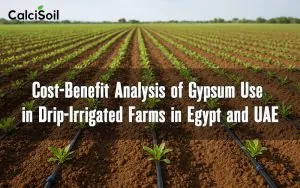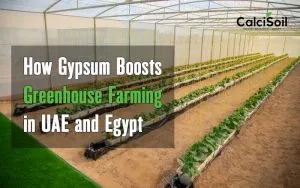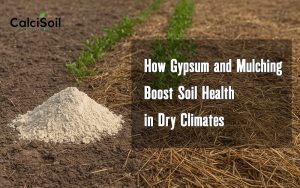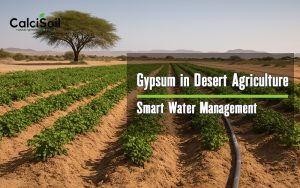
Agricultural gypsum is an effective and versatile soil amendment that improves soil fertility, structure, and environmental sustainability – leading to better crop yields and quality. The calcium, sulfur, and physical benefits it provides make it a valuable input for many types of crops. However, a pertinent inquiry that warrants consideration is the optimal quantity of agricultural gypsum required for each plant.
General guides for gypsum application
The gypsum application rates for different crops vary based on factors such as soil type, depth of incorporation, and crop requirements. Here are some general guidelines:
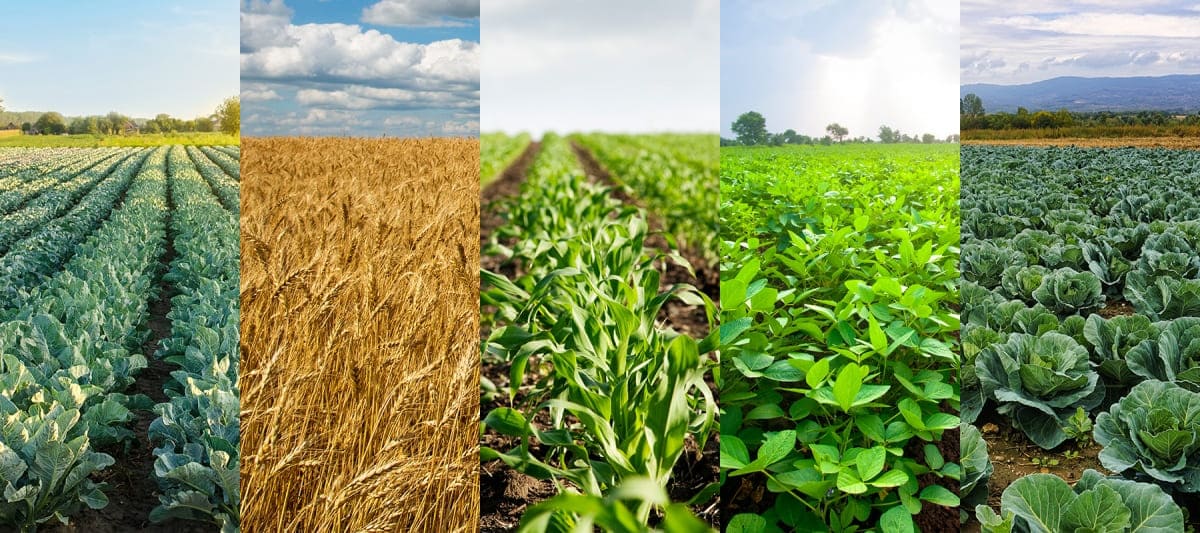
Field Crops:
For crops with a Ca:Mg ratio less than 1.5, apply 6 tons per hectare (t/ha).
For crops with a Ca:Mg ratio between 1.5 and 2.0, apply 4 t/ha.
For crops with a Ca:Mg ratio between 2.0 and 2.5, apply 2 t/ha.
For crops with a Ca:Mg ratio greater than 2.5, no gypsum is recommended.
Horticulture (Trees, Vines, and Vegetables):
For horticulture, apply 7.5-10 t/ha for a Ca:Mg ratio less than 1.5.
For a Ca:Mg ratio between 1.5 and 2.0, apply 5-7.5 t/ha.
For a Ca:Mg ratio between 2.0 and 2.5, apply 2.5-5 t/ha.
For a Ca:Mg ratio greater than 2.5, apply 6.3 t/ha.
Arable Crops:
For arable crops, high-rate applications of gypsum are recommended for soils with structural problems.
For cereals like barley, wheat, maize, and oats, apply gypsum to improve soil structure and calcium levels.
Soybean and Other Crops:
For soybean and other crops, gypsum can be applied at rates of up to 1,000-4,000 pounds per acre (lbs/acre) to enhance yield and quality.
Peanuts:
For peanuts, apply gypsum at 0.5 tons per acre to increase yield and calcium concentration in peanut seeds.
These rates are general guidelines and may need to be adjusted based on specific soil conditions, crop requirements, and local regulations. It is recommended to consult with local agricultural experts or conduct soil tests to determine the optimal application rates for your specific situation.
Methods to determine required amount of agricultural gypsum application
Several methods are used to determine the required amount of gypsum for agricultural purposes. These methods include:
Field Observation and Dispersion Tests
Field Observation: Observing the soil’s physical properties, such as its structure and porosity, can help identify the need for gypsum.
Dispersion Tests: Dry aggregate dispersion tests can assess the soil’s dispersion degree, which is crucial in determining the need for gypsum.
Chemical Methods
Wet Chemical Methods: These methods involve the use of chemicals to detect and quantify gypsum in soils. However, they can be cumbersome and imprecise.
Turbidimetry: This method is based on the precipitation of gypsum, which can be detected through turbidity measurements.
Colorimetric Methods: These methods involve the use of colorimetric techniques to detect and quantify gypsum in soils.
Physical Methods
Loss of Crystal Water: This method involves heating soil samples to determine the loss of crystal water, which can indicate the presence of gypsum.
X-ray Diffraction: This method involves using X-rays to identify the presence of gypsum in soils. It can be time-consuming and requires specialized equipment.
Rapid Methods
Omran GypSim Method: This method is a simple, rapid, and inexpensive method for determining gypsum content in soils. It has been found to be more accurate and reproducible than other methods.
Gravimetric Methods: These methods involve the use of gravimetry to determine gypsum content. They are easy to perform but require specialized equipment.
Sampling and Analysis
Sampling FGD Gypsum: Sampling FGD gypsum for analysis involves collecting representative samples from different storage systems and analyzing them for calcium, sulfur, and other elements of environmental concern.
Sampling Soil: Sampling soil for analysis involves collecting representative soil samples and analyzing them for gypsum content using various methods.
These methods help determine the gypsum content in soils, which is essential for deciding the appropriate application rate for agricultural purposes. The choice of method depends on factors such as the type of soil, crop requirements, and the desired level of accuracy.

